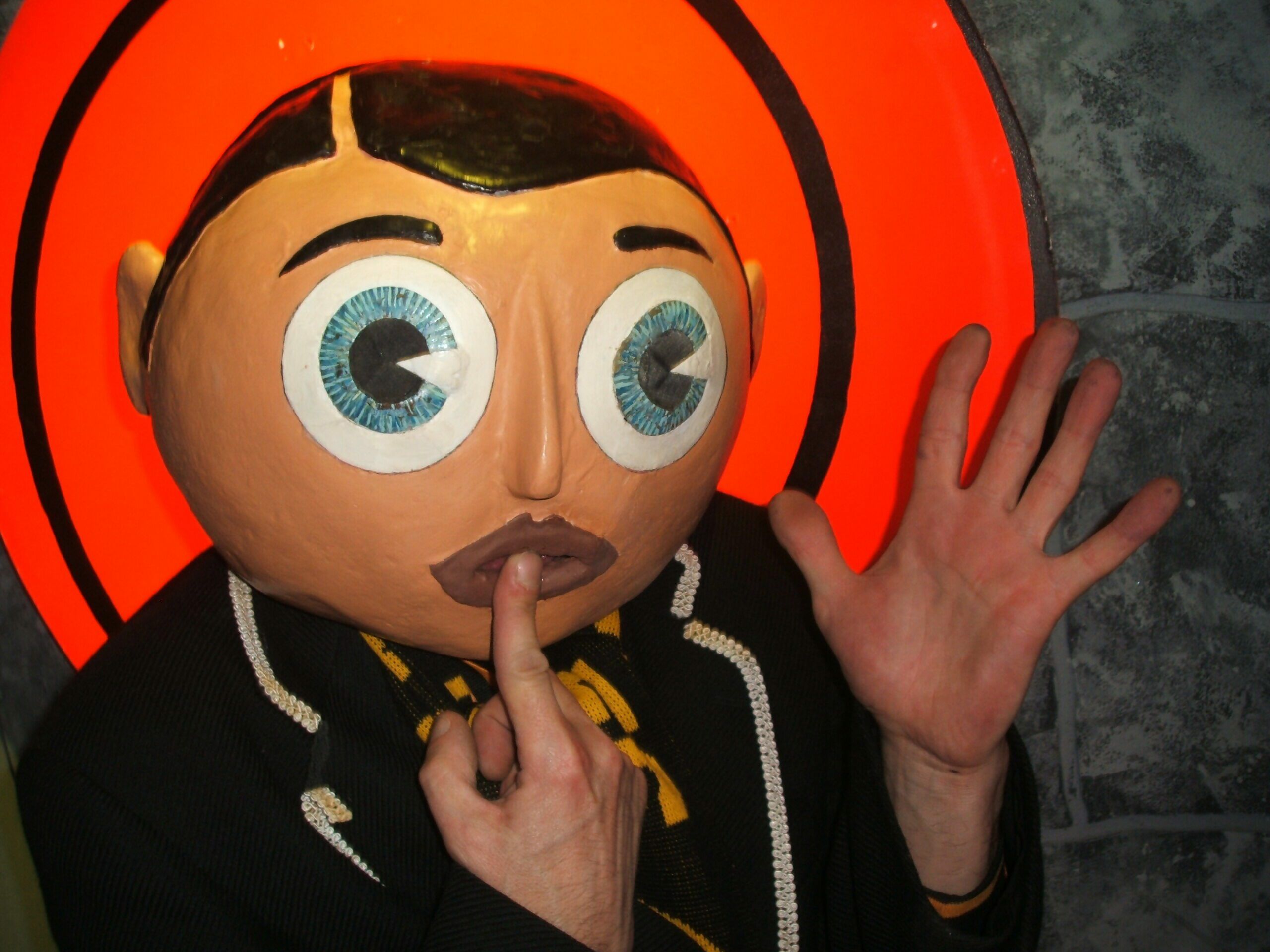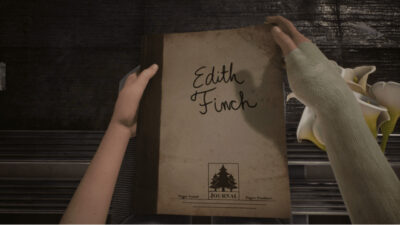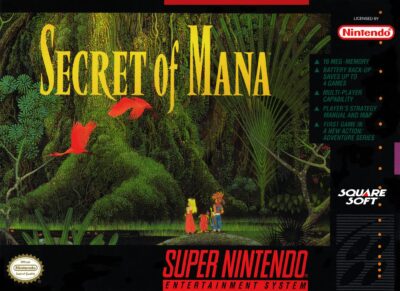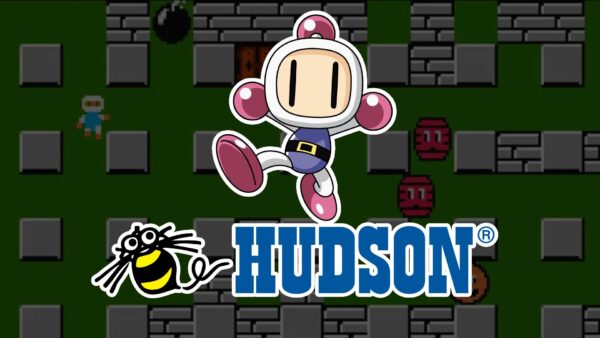
Chris Sievey always wanted to be famous. The musician, who later became known as the papier mâché-headed comedy character Frank Sidebottom, released several singles in the seventies and eighties, both as a solo act and as part of the Manchester pop-punk group The Freshies, but he never quite managed to break the top 40. The closest he got was in 1980, when The Freshies’ single, I’m In Love With The Girl On The Virgin Megastore Check-out Desk, reached number 54 in the UK singles chart. Top of the Pops booked the band to play on the programme, but a BBC technicians’ strike cancelled that week’s show. It was a huge setback, but Sievey never gave up. He continued making music, and even adopted game development as a unique way to promote his singles.
Sievey made his own music videos in BASIC on the Sinclair ZX81, and packaged singles alongside his games on record and cassette. It’s an aspect of his career that has gone criminally underexplored due to the shadow of his more popular creations, but it stands as a testament to an artist way ahead of his time. Sievey passed away in June 2010, but his fans, family, and friends are still hard at work keeping his legacy alive today. We spoke to them about the man behind the mask, how his career in music helped influence his video games, and how it led to the birth of his most popular creation, Frank Sidebottom.
The First Computer Pop Star
In 1982, shortly after disbanding The Freshies, Sievey took two of his children to pay a phone bill in his local town centre when he spotted a ZX81 in a shop window. Completely forgetting about the phone bill, he bought the computer and took it home, hoping to use it to make titles to superimpose over video.
“My dad went out of his way to get that computer,” remembers Stirling, Chris Sievey’s son. “When he put his mind to something, that was it. He was focused on it. When he got it home, he was determined he was going to learn how to make programs and stuff with it. He used to stay up at night tinkering away. When we were young kids, it just looked like a load of nonsense on a screen, but when he presented a game to you, it was like, ‘Oh, wow, this actually works.’”
Over the next three weeks without a phone, Sievey learned how to code in BASIC. Then, one January day, he was writing a program of a bouncing ball when he had the idea to sync up the animation to a single he’d recently recorded with Joy Division’s producer Martin Hannett, called Camouflage. Camouflage was a love song that used the Cold War and the Berlin Wall as an allegory for a broken relationship, so Sievey took the bouncing ball and added some more complex graphics, including lyrics, an American flag, and a figure that danced to the music.

The record sleeve for Camouflage – “the world’s first computer promo”.
He released the music video in April 1982 with a short computer program teasing “Camouflage soon”. A year later, he released Camouflage as a single on his Random Records label, producing only 2000 copies for its initial run. The single came on vinyl and cassette, with one side of the record containing the title track, while the other featured a screeching wall of sound – the data for three computer programs. This included the music video for Camouflage, and two versions of a psychedelic video game called Flying Train, where you had to pilot a flying locomotive through a time gate in space. Sievey made the game as a joke.
“I think Chris was hedging his bets by putting a record out with the first computer promo on,” says his friend and former roadie, Dave Arnold. “He was hoping 50% would buy it because it was a music-related thing, and 50% would buy it because it had a video game on the back. Win-win. But (like others have said), it didn’t really work because if you got a bit of fluff on the needle or it got a scratch, it slightly altered the sonics of the whole thing and then it was knackered.”

A statue to Frank being unveiled in his home town of Timperley, where it remains to this day.
To get any of the games to work on vinyl was an ordeal. Players had to go through the difficult process of transferring the data from record to tape, with any slight defects capable of preventing the program from loading. If all went well, however, players could load the programs from tape, or in the case of the record, flip it over to side A on a record player and sync the beginning of the track to the music video.
The results were incredible – when it worked – and garnered positive attention. The record label EMI picked up the single for a wider release, and commissioned a standalone colour version of Flying Train for the ZX Spectrum. Meanwhile, TV programmes like The Tube and The Old Grey Whistle Test carried segments demonstrating Camouflage’s unique pop video. This wasn’t enough, however, to get the single to chart.

Chris Sievey talking with Tony Fletcher about his video game work on The Tube, a Channel 4 show for upcoming bands.
‘The Biz’
Sievey wasn’t deterred. Instead, he put his frustration with the music business and lack of chart success into his next game, The Biz, released by Virgin in 1984. It was a music industry sim that bore some similarities to Kevin Toms’ Football Manager series, one of Sievey’s favourite games. You created a band, played live shows, and appeared on TV, with the goal being to get your song to number one on the charts. Along the way, you’d have to deal with thieves, the perils of drug and alcohol addiction, and the economics of making it in the music business. All of which made the game almost impossible to beat. Prior to releasing the game, Sievey held a competition offering a prize for whoever could beat it, but to our knowledge, no one ever did.
“The interesting thing about The Biz is that the (goal) was to get to number one in the record charts,” says Steve Sullivan, director of Being Frank: The Chris Sievey Story. “This was Chris’ own personal obsession in real life. But… it was (almost) impossible to ever reach number one in the charts. The game was rigged against you…”

The Biz got a respectable bit of coverage in the games magazines of the day. Picture credit: Squirrel Natkin.
“It’s extremely difficult,” says Martin Lyons, who Sullivan tasked with looking into the game’s code ahead of the documentary. “It’s like ‘winning the lottery’ levels of difficulty. I calculated all the probabilities and it was like 40 to 50 million to one. That is perfect as a kind of analogy. To win the game and get to number one, you basically have to win the lottery. It’s not impossible, but it’s extremely difficult, and you have to be extremely lucky because of the randomness that goes into it.”
With these kinds of odds, you may be wondering why no one cheated, but as Lyons discovered, Sievey had made it difficult to see the end of the game without completing it legitimately. “(The program) goes to the end of the code and sets up some variables that equals some numbers,” explains Lyons. “So T=10 or TT=100, but (the code) doesn’t say TT=100, it just says TT=TxT. So it creates all these variables with numbers. Then all the way through the code, when using goto statements, (Sievey) doesn’t say goto 2500, he’ll say TT+Tx3+whatever. Every time he’s creating a variable, he’s making it in the most complex way possible, and so you can’t cheat, because there’s no way of knowing how to cheat. Thirty years later I can look at this code in an editor; I can easily replace and change things to make it readable. You couldn’t do that in 1984. For somebody to hack this back then as a pen-and-paper exercise would have taken weeks of work.”
As a result, most hackers would have simply looked at the code and decided that the prize wasn’t worth the effort.

The disarmingly odd Flying Train on the ZX Spectrum.
Becoming Frank
Besides a competition almost nobody could win, Sievey also promoted The Biz through other methods. The game came pre-packaged with his biggest hits from The Freshies, as well as an interview between him and his new comedy creation, Frank Sidebottom. Frank was an aspiring pop star from the small village of Timperley who still lived at home with his mum, had a cheery, often naive outlook on life, and boasted an enormous papier mâché head. Sievey conceived Frank as a way to promote his music with The Freshies, but he quickly took on a life of his own, and soon became more famous than his creator.
“I think there were 24 consecutive flop records,” says Arnold. “He just got to a point where he thought ‘Bollocks to it’. The whole Frank thing was a reaction to struggling so hard to be famous. He came up with this anti-pop star. Chris said to me, ‘All Frank is, is how much of your time can I waste?’”

Chris Sievey in full Frank Sidebottom mode. Credit: Dave Arnold.
“I think he started to realise Frank was the famous one,” says Stirling. “But he was still in the background recording music at home by himself. He had a couple of albums’ worth of material that he was looking to release, but he never got around to doing it… I think he did the Frank thing to get a bit of money coming in, so he could spend time doing what he wanted to do, which was writing music.”
After The Biz, Sievey vanished behind his comedy persona. He sent a letter to EMI and got signed to produce comedy albums, and started touring the UK. Though he had no chart success with Frank either, the character developed a cult following, and became a regular fixture on children’s TV. But Sievey wasn’t done with computers just yet.

After The Biz, Sievey signed with EMI again, this time as Frank.
In his new career under the head, Sievey started writing a Frank Sidebottom comic strip for Oink! magazine in 1986, which led to a crossover with Crash Magazine, where he published his two final programs, Amoeba Rescue and The Charming Eggtimer. While The Charming Eggtimer is fairly self-explanatory – it helped users boil the perfect egg – Amoeba Rescue requires a bit more of an explanation.
It involved holding your finger to the screen and guessing which pixel would appear. If you guessed the spot correctly, then you’d rescued ‘the amoeba’ and won the game. Interestingly, Sievey didn’t credit these games to himself, but to Frank, taking on the persona not only in his music career but in his games too.
“He never made it big in the way he wanted to… but he was really good at everything,” says Stirling. “I know the music didn’t really take off, but he’s done computer games, he’s done comic books, he’s done animation. It’s like, people would be happy to do just one of (those things), but he’s done them all.”

Unbeatable: Chris Sievey’s music industry sim (and parody), The Biz.
After Sievey passed away in June 2010 from cancer, his family donated his archive to the Central Library in Manchester. It’s hoped that this will help catalogue his innovative work across multiple mediums and ensure future generations can continue engaging with his art. Over the last few years, more and more people have started to look beyond Frank, at the man behind the mask, and have finally started celebrating the figure for his endeavours outside comedy. It’s about time.
Secret Codes
Sievey told many of his friends that MI5 had once approached him with a job. Most people thought he was joking, but he showed a keen interest in steganography throughout his life. As well as The Biz’s bizarre coding methods, fans also spotted a coloured pattern on most of his album sleeves and newsletters that reputedly contained a hidden message. No one knew what this pattern meant, until 2019 when GCHQ cracked the code, revealing the message, “Why does my nose hurt after concerts?” – a reference to the peg Sievey wore on his nose to achieve Frank’s nasally tone.





